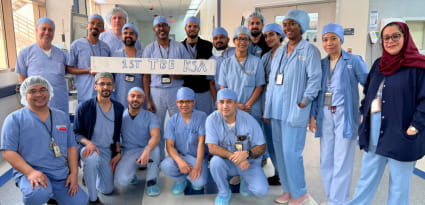
JHAH Surgeons Save Patient’s Life with First Aortic Implant Procedure of its Kind in Kingdom
The 78-year-old patient was implanted with a thoracic branch endoprosthesis, a new type of stent-graft.
A patient who presented at Johns Hopkins Aramco Healthcare (JHAH) with a life-threatening bleed from their aorta was saved by clinicians who conducted the first aortic implant procedure of its kind in Saudi Arabia.
A JHAH surgical team successfully implanted a thoracic branch endoprosthesis (TBE) — a new type of aortic implant — in a procedure that had taken place only once before in the Middle East.
The 78-year-old male patient presented with a bleeding ulcer in the wall of their aorta — the artery that carries blood from the heart to the rest of the body. Doctors feared that the patient’s aorta could rupture, putting his life at risk.
“We were monitoring the patient with regular CT scans to assess the progression of the bleed and the depth of the ulcer in the wall of the aorta, and the situation was getting progressively worse,” said Dr. Tarig Bakarat, a consultant vascular surgeon at JHAH who undertook the TBE procedure. “We were trying to control his blood pressure, but it wasn’t working.”
A complicating factor was that the patient had a severe narrowing of both his carotid arteries — two blood vessels in the neck that carry blood to the brain — of around 80%. Further, the patient had previously undergone coronary artery bypass surgery.
The decision was taken to implant the TBE using minimally invasive surgery rather than risk another bypass procedure through open surgery.
The TBE is a new type of stent-graft — a reinforced tube that is placed inside a blood vessel to reinforce the blood vessel’s wall and improve blood flow. The TBE, which is placed inside the aorta, is unique because it incorporates a side-branch that connects it to and reinforces the left subclavian artery — the artery that supplies blood to the head and left arm — while simultaneously reinforcing the aortic arch. This unique connection meant that in this case, the patient’s aorta could be repaired without the need for a bypass procedure to reroute blood flow to the left subclavian artery. This could have compromised blood flow to the heart through a graft which had been created during the patient’s previous coronary artery bypass surgery.
“This procedure saved the patient’s life,” Dr. Bakarat said. “Importantly, the branch in the stent meant that we were able to perform surgery using minimally invasive techniques. This meant that we did not need to open the patient’s neck to access his carotid arteries, which reduced the risk of major complications such as stroke or heart attack.”
The JHAH surgical team was led by Dr. Barakat, assisted by Dr. Abubakr Ahmed, general surgery and vascular surgery consultant; Dr. Asim Shah and Dr. Mustafa Fleet, consultant interventional radiologists; and Dr. Fatima Al Jeshi and Dr. Talal Al Ghamdi, anesthetists.
The team used a TBE manufactured by Gore Medical, which is the only off-the-shelf TBE approved by the U.S. Food and Drug Administration.
The procedure, which was undertaken in August, took about three hours. The patient was discharged two weeks after surgery and recovered well.
The procedure was confirmed as the first of its kind to have taken place in Saudi Arabia, and the second in the Middle East, by Med Surg Solutions, which supplies the Gore Medical TBE device to hospitals across the region.
